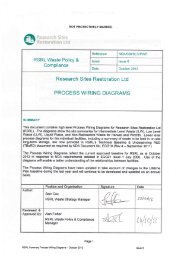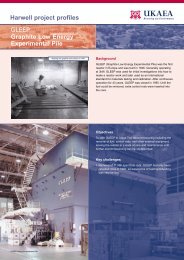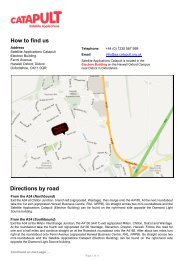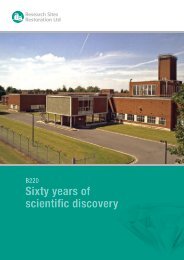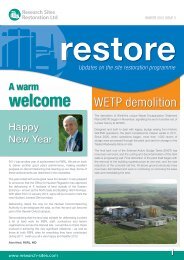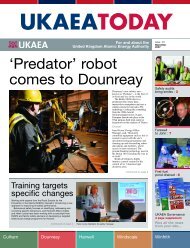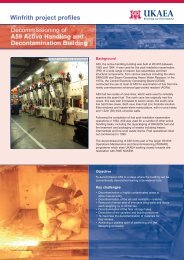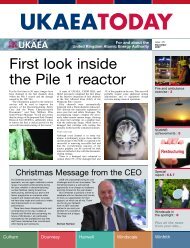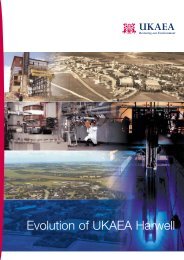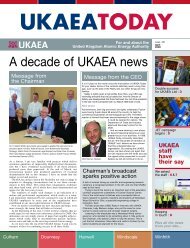RSRL Integrated Waste Strategy - Issue 5- Oct 2012.pdf
RSRL Integrated Waste Strategy - Issue 5- Oct 2012.pdf
RSRL Integrated Waste Strategy - Issue 5- Oct 2012.pdf
Create successful ePaper yourself
Turn your PDF publications into a flip-book with our unique Google optimized e-Paper software.
NOT PROTECTIVELY MARKEDdecontaminates low level wastes to allow part to be treated as exempt (‘out of scope’)waste. Cutting is carried out on certain large items of solid LLW and surface removal ofcontaminated plant and equipment is also undertaken to remove the surface contaminationto enable disposal of the bulk of the item as exempt (‘out of scope’) waste (see 7.3.1 and7.3.2 for management of potentially exempt waste (PEW)). The Winfrith Abrasive CleaningMachine (WACM) may be used to decontaminate surface contaminated metallic waste onsite. Alternatively, metallic waste may be transferred off-site for further treatment under thecontact with LLWR.315. Where LLW items cannot be decontaminated, the current practice is to collect thewastes from the on-site facilities for supercompaction. Drums of similar LLW are alsoconsigned from Harwell for supercompaction. Following supercompaction, pucks are placedin containers that are approved for transport and disposal and then transferred to LLWR fordisposal. Bulk LLW is placed directly into approved containers at source for transfer toLLWR.316. The site waste BPEO Study identified two potential options for the management of thenon-combustible LLW generated at Winfrith: disposal to the LLWR (as per current practice)and on-site disposal. However only disposal to the LLWR was identified as being practicallyfeasible for the more radioactive low level wastes. The end state for the Winfrith site is a delicensedsite and it was considered that on-site disposal of LLW would not be compatiblewith the ONR de-licensing criteria. This position excludes metallic wastes that areaddressed by a separate BAT Assessment which concluded that on-site treatment wasBAT, closely followed by off-site treatment.317. Although disposal to the LLWR is a well established and existing disposal route, Winfrithrecognises that the future availability of the facility is a risk however it is considered that thisis a wider industry issue that will require higher level decision making by the NDA.7.1.3.3 Soft Solid LLW318. Soft solid LLW, such as personally protective equipment, clothing, wood etc. may arisefrom any activities within the radiation and contamination controlled areas on the site.Where it is practicable to do so, soft solid LLW is differentiated from other LLW and thesewaste are segregated at source. <strong>RSRL</strong> is developing arrangements with LLWR to establisha combustible waste disposal service in order that segregated wastes may be transferred toan off-site treatment facility. Arrangements for the segregation of combustible soft solidwastes are still developing, but <strong>RSRL</strong> is committed to doing so in recognition thatincineration services are available through the contract with LLWR and incineration hasbeen identified as BAT at strategic level for soft solid wastes.7.1.3.4 Solid HV-VLLW319. Significant quantities of VLLW will be produced as a result of the decommissioningactivities at the Winfrith site. An Authorisation is in place at Winfrith for the disposal ofVLLW to local landfill however due to the annual limits associated with this route, along withnuclear liability insurance issues, <strong>RSRL</strong> is currently considering alternative routes such asthat utilised by the Harwell site.320. In 2010 the EA issued a variation to the Winfrith Authorisation thereby enabling thedisposal of high volume VLLW via the service offered by LLWR. In 2011, followingnegotiations between <strong>RSRL</strong> and EA, the EA amended the CEAR (Compilation of EARequirements, Approvals and Specifications) to set a volume limit for HV-VLLW transferredvia LLWR.<strong>RSRL</strong> IWS (<strong>Issue</strong> 5 – <strong>Oct</strong>ober 2012)87




